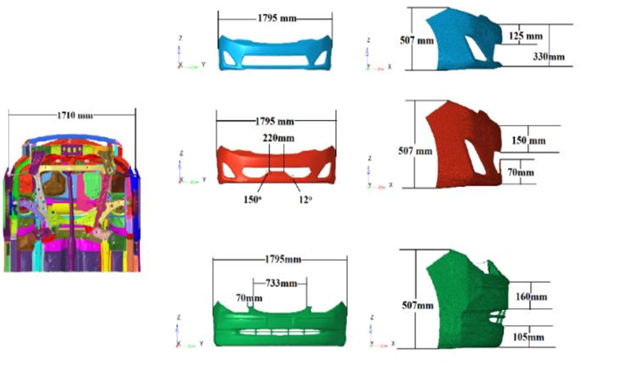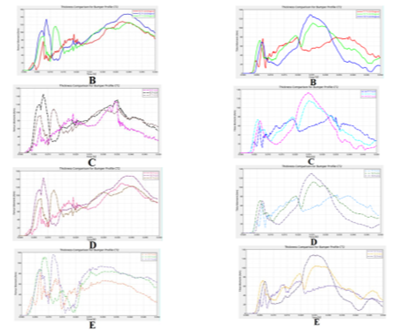Introduction
Pedestrian collisions with vehicles are a growing safety concern, especially in urban environments with high traffic density. Traditional vehicle bumpers are designed primarily for crash energy absorption between vehicles, not for minimizing pedestrian injuries. This limitation inspired a Vietnamese research team to apply simulation-based design and optimization to improve pedestrian safety performance.
Understanding Pedestrian Impact Dynamics
During a collision, pedestrians experience complex kinematic responses — translation, rotation, and deformation — influenced by bumper height, stiffness, and geometry. The research applied momentum change theory and angular motion equations to model the rotational motion and energy transfer between vehicle and pedestrian.
The relative impact velocity (p, p’) and impact pulse (S) were identified as dominant factors affecting injury severity.
 Figure 1: Front bumper profile parameters
Figure 1: Front bumper profile parameters
Simulation Method
Using the V-THUMS human body model, researchers analyzed how forces act on different sections of the lower limb during impact. Injury criteria included:
- Von-Mises stress
- Bending moment threshold
- Ligament deformation limits (25% rupture threshold)
Different materials and geometries were tested under consistent impact speeds, allowing accurate comparative evaluation of design performance.
Key Simulation Results
- Profile Optimization:
The second redesigned profile (Shape 2) distributed forces more evenly, reducing peak impact loads on the femur and tibia by up to 15%. - Material Behavior:
PP-TD20 plastic achieved the lowest injury indices (femur: 140 Nm; tibia: 128 Nm), outperforming steel and aluminum in energy absorption. - Thickness Variation:
Reducing thickness below 2.0 mm increased deformation risk, while exceeding 4.0 mm increased pedestrian injury.
Optimal range: 2.5–3.0 mm.
 Figure 2: General plot comparing thickness at femur and tibia
Figure 2: General plot comparing thickness at femur and tibia
Ligament and Stress Evaluation
The study also examined the ligament failure threshold of the knee joint (ACL, PCL, MCL, LCL). The optimized bumper successfully reduced ligament rupture incidence by limiting deformation to below 25%. Stress visualization confirmed that energy concentration shifted away from high-risk zones.
Research Significance
This research contributes to global pedestrian safety initiatives by integrating biomechanics and computational modeling. The results offer valuable insights for:
- Automotive manufacturers seeking to meet pedestrian safety standards (EEVC/WG17),
- Policy regulators developing pedestrian protection policies,
- Educators and students in automotive design and crash simulation.
Conclusion
Through advanced finite element analysis, this study confirms that profile, material, and thickness optimization can substantially reduce pedestrian injury severity. The outcomes demonstrate how simulation-driven design can create safer, smarter vehicles aligned with future safety regulations and sustainability goals.